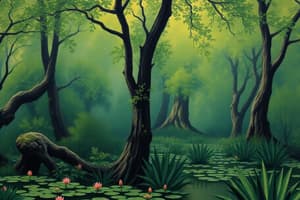Podcast
Questions and Answers
Match the following components of the environment with their descriptions:
Match the following components of the environment with their descriptions:
Atmosphere = The gaseous layers that surround the earth Lithosphere = The solid portion of the earth, composed of minerals Hydrosphere = Includes all types of water bodies found on Earth Biosphere = The living component of the environment
Match the following components with their types in the environment:
Match the following components with their types in the environment:
Abiotic Components = Non-living factors like air, water, soil, and climate Biotic Components = Living organisms like plants, animals, and microorganisms Natural Pollutants = Substances introduced into the environment naturally Anthropogenic Pollutants = Pollutants originating from human activities
Match the following pollutants with their definitions:
Match the following pollutants with their definitions:
Volcanic Eruptions = Natural pollutant introduced into the environment Carbon Dioxide (CO2) = Anthropogenic pollutant from human activities Dust and Soil Particles = Natural pollutant with undesired effects Sulfur Dioxide (SO2) = Anthropogenic pollutant adversely affecting resources
Match the following terms with their meanings:
Match the following terms with their meanings:
Match these ecological spheres with their descriptions:
Match these ecological spheres with their descriptions:
Match the following terms with their definitions:
Match the following terms with their definitions:
Match the following terms with their descriptions:
Match the following terms with their descriptions:
Match the following resource types with examples:
Match the following resource types with examples:
Match the following terms with their roles in the environment:
Match the following terms with their roles in the environment:
Match the following concepts with their categories:
Match the following concepts with their categories:
Flashcards are hidden until you start studying




